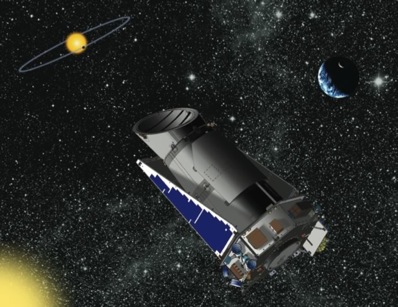BY DR EMILY BALDWIN
ASTRONOMY NOW
ASTRONOMY NOW
Posted: October 20, 2008
Earth-like planets may be easier to spot than planet-hunters originally thought, since their hot, molten surfaces may exist for tens of millions of years, presenting them as glowing beacons as they orbit their parent stars. Speaking at the American Astronomical Society's Division for Planetary Sciences meeting last week, MIT planetary scientist Linda Elkins-Tanton spoke of how the 'magma ocean' stage for Earth-sized planets – the period when a new born planet is mostly molten magma and has yet to solidify into a distinct core, mantle and crust – may last for a much longer period of time than previously thought. The research shows that even after the surface magma solidifies, within about five million years, it could stay hot enough to glow brightly in infrared light for tens of millions of years, providing a relatively long window for detectability. "That means we may actually see them elsewhere, as detection systems get better," she says.

It is hoped that the Kepler mission, launching in March 2009, will detect tens of Earth-sized planets orbiting other stars. Image: Image.
One of the biggest challenges for astronomers hoping to detect planets around other stars is the vast difference in brightness between the star and the planet, which shines only by reflecting light from its parent star. But the difference in brightness in infrared wavelengths for a glowing, molten planetary surface would be much less, making the detection more feasible.According to Elkins-Tanton, the long-lived molten stage of planet formation results from a two-stage process, beginning with the combination of heat generated by the influx of rocks that collide and coalesce to form the planet in the first place, and from radioactive decay in the planet's interior. However, this period is relatively short lived and the planet's surface is expected to solidify quickly within a few hundred thousand years. But in the revised model a secondary upheaval begins, in which heavier iron-rich material that has solidified at the surface begins to sink toward the core, causing other hotter material to rise to the surface. This overturn process, which is a bit like the rise and fall of 'lava' in a lava lamp, extends the period that the planet's surface remains molten to millions of years.
But because the Earth is so dynamic – the process of plate tectonics means the Earth's crust is constantly being destroyed and recreated – there is no material left from that initial epoch that could be studied to test this idea. But by looking at Mars or Mercury, Elkins-Tanton may find the evidence she needs to support her theory, especially since her work leads to specific conclusions about the surface composition of different planets. So the detection of specific minerals on Mercury, for example, which the MESSENGER spacecraft may be able to carry out when it begins its study of the planet in 2011, might offer some support to the theory.
And as planet-hunting techniques improve, the detection of hot young planets glowing brightly in infrared around their parent stars may also be realised. Indeed, the search for rocky, Earthlike planets is the primary goal of the Kepler mission which is currently scheduled for launch in March 2009, so Elkins-Tanton and the rest of the planet-hunting community may not have long to wait.
.
.
Lucimary Vargas
Presidente
Observatório Astronômico Monoceros
Além Paraíba-MG-Brasil
observatorio.monoceros@gmail.com
Presidente
Observatório Astronômico Monoceros
Além Paraíba-MG-Brasil
observatorio.monoceros@gmail.com

Nenhum comentário:
Postar um comentário